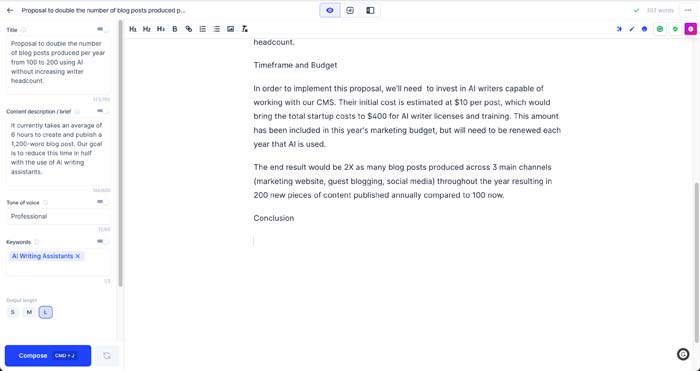This article will show you how to write a proposal with the help of AI tools in a fraction of the time it would take you to do so manually.
The reason proposal writing is such an important key for businesses is because they work. On average, companies respond to 62% of the proposals they receive after making an RFP.
Now, writing a proposal from scratch can be a tedious task that may take several hours perhaps stretching out to days.
Thankfully, there are now new AI-based writing assistant tools available that can help you come up with your first draft in mere minutes.
In this article, we’ll look at how AI writing tools can be used to create professional-looking proposals with a lot less effort on your part, and we’ll even create a new proposal from beginning to end as an example so you can see how these tools work in a real-world situation.
Key Takeaways
Disclosure: Although I receive affiliate compensation at no additional cost to you to support this site that compensation in no way influences my recommendations, which are strictly informed by my 10+ years of online business experience consulting for clients large and small. My aim is to always recommend tools that offer the best return for your investment (for more details, read my Affiliate Disclosure).
The Basic Elements of a Proposal
There are many ways to structure a proposal, depending on your field of work (business, technical, scientific, scholastic. etc.) and the nature of the audience (peers, prospects, clients, governmental organizations, etc.)
But, the essential elements are the same. At a minimum, you’ll need:
- An executive summary
- A statement of the problem you propose to solve
- Your proposed solution
- Your proposed time frame and costs
- A conclusion, summarizing the costs and benefits
In addition, and depending on your circumstances, you may need a cover page, a table of contents, signature pages, etc, but for the sake of brevity, we’ll exclude those from this article.
The Benefits of Using AI to Write Proposals
AI-based writing is a new way to automatically generate content harnessing the power of artificial intelligence deep learning techniques.
These tools use natural language processing and neural networks to understand the meaning of words and to figure out how to generate human-like content through rapid iterative learning.
In essence they're trained by reading and analyzing tens of millions of web pages, learning to put together sentences that are indistinguishable from human writers.
How to Write a Proposal With AI Writing Tools

If you're looking for a human writing assistant to help you write your proposal, you’ll need to provide them with clear instructions on what they should do.
This is no different when you work with AI software. The first thing you need to do is to give it guidelines about your topic and what you intend to achieve with your proposal.
Now, don’t expect AI writing assistants to take in this information and generate the entire document in one fell swoop. You’ll need to break down your proposal into segments and work on one element at a time.
Having said that, AI is not the end all and be all of writer automation. There are some limitations you need to be aware of:
AI writing assistants are good at:
- Generating content just like a human writer, both in style and tone of voice
- Quickly coming up with new angles, sentence ideas and ways of framing a subject you may not have thought of
- Dramatically reducing the time it takes to go from blank slate to first draft
AI writing assistants are not good at:
- Accuracy in facts and figures — in most cases they’ll just make stuff up to fit the narrative they’re creating
- Thinking creatively like a human writer
- Topical expertise. Although they can write about anything under the sun, they have no accumulated knowledge about any topic in particular. That’s why it’s a bad idea to use an AI writing assistant to cover a topic you know nothing about
Example: Using AI Writing Tools to Draft a Proposal in Minutes
For this example, I’m going to use Jarvis.ai, the leading tool on the market and the goto for content creators and professional writers (Rytr is another popular choice.)
I’ll be using the Long-Form Assistant content generation template to come up with the entire structure of our proposal, which we’ll use as a first draft that we can then build on.
In this example, I’m going to use Jarvis to show you how to write a proposal that pitches the use of AI writing assistants to the management of a fictional company.
Template inputs
The inputs for this template are the proposal’s title, which in this case will be:
“Proposal to double the number of blog posts produced per year from 100 to 200 using AI without increasing writer headcount.”
a description of the content to be generated, or a brief:
“It currently takes an average of 6 hours to create and publish a 1,200-word blog post. Our goal is to reduce this time in half with the use of AI writing assistants.”
the chosen tone of voice: professional
and the main keyword for this content piece:
“AI Writing Assistants”
This is what the template looks like so far:

Next, I’m going to let the tool generate the first element of our proposal, the executive summary. In order to do so, I’ll give it some direction by typing the first sentence...

...and and then clicking the blue Compose button:

Awesome! Now, I’ll create another starter sentence for a second paragraph...

...and hit the Compose button one more time:

Great.
Problem statement
Next, I’ll add the next proposal element, the problem statement, and I’ll help Jarvis out by typing the heading “Problem:” followed by another starter sentence...

...and clicking Compose one more time:

Jarvis was clever enough to complete the sentence and even propose a solution.
Time to move on to the next proposal element, the timeframe and budget.
So, I’m going to go ahead and write the new heading: “Timeframe and Budget” followed by a new starter sentence...

...and click Compose:

So far so good. Now, here we’ll need to begin replacing placeholder figures with real world data, since Jarvis is just making them up to fit the narrative.
Finally, we’re going to wrap our proposal up by typing the heading “Conclusion”...

...and hitting the Compose button (I’m skipping the starter sentence here because I’m curious to see what Jarvis will do 😉

Again, here we’ll need to replace all made-up figures Jarvis added to the text with real ones from our research.
Here’s the full first draft of our proposal auto generated by Jarvis:
“Executive Summary:
AI writing assistants hold the promise of increasing the throughput of our content creation department without having to add headcount. In fact, AI assistants could potentially double the throughput of our writers. AI writing assistants also enable us to autogenerate more types of content, such as video scripts, marketing emails, SEO metadata content, ad headlines and descriptions, and even quora answers.
It currently takes an average of 6 hours to create and publish a 1,200-word blog post. With the use of AI writing assistants, we can reduce this time to 3 hours. AI assistants could also be used throughout the content lifecycle—from research and ideation, all the way to publishing. This would free up our writers from spending as much time on routine tasks, allowing them to focus more on creating high-quality original content for our blog.
Problem:
To stay ahead of the competition we need to double the number of blog posts published every year, but this will require twice as many writers.
Solution:
Instead of increasing the number of writers by 100%, AI writing assistants would reduce the time needed to publish blog posts in half, which gives our company enough room to increase our content output without having to hire additional headcount.
Timeframe and Budget:
In order to implement this proposal, we'll need to invest in AI writers capable of working with our CMS. Their initial cost is estimated at $10 per post, which would bring the total startup costs to $400 for AI writer licenses and training. This amount has been included in this year's marketing budget, but will need to be renewed each year that AI is used.
The end result would be 2X as many blog posts produced across 3 main channels (marketing website, guest blogging, social media) throughout the year resulting in 200 new pieces of content published annually compared to 100 now.
Conclusion:
AI writing assistants could double our number of blog posts produced per year from 100 to 200 without increasing writer headcount.
This is a new state-of-the-art technology that has been gaining traction lately and would allow us to stay ahead of the curve. Our proposed AI writing assistant comes with a yearly license of $10/1,000 words. The estimated payback period on AI writers is 3 months based on our current production rate and labor costs associated with blogging.”
____________________________________________
All of the above took me approximately 10 minutes to generate! Now, all we have to do is to add more meat to the bones to have a fully fleshed out proposal we can present to the management team.
Except that instead of taking many hours to come up with something new from scratch, we’ll be able to crank this out in under an hour.
Next Steps
Not only can AI writing assistants save you a ton of time coming up with proposal drafts, but also be leveraged for many other time-consuming writing tasks.
So, do you want to jump ahead of the competition? Jarvis offers a 7-day money-back guarantee. Why not give it a try!







